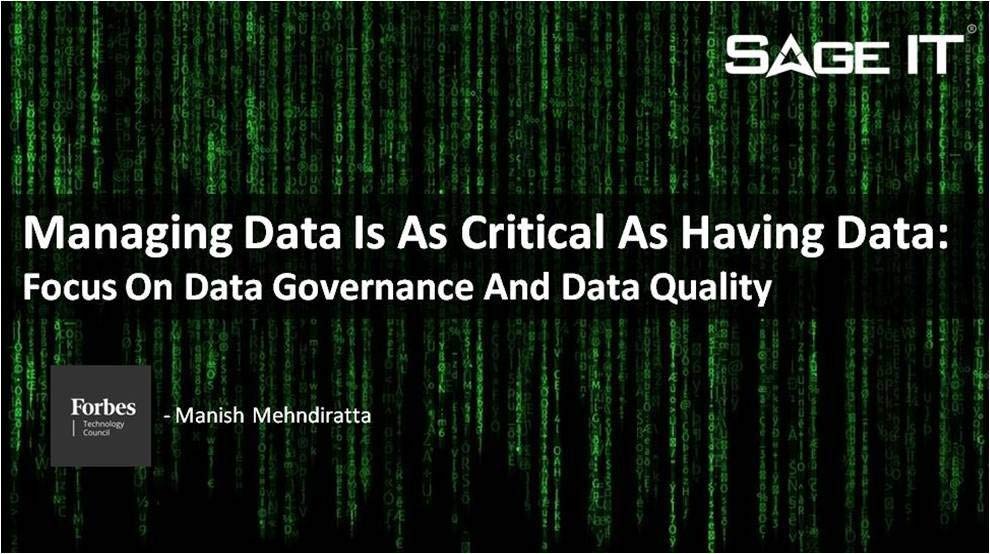
In the eyes of many, data — clean, clear and accurate data — rules the universe. When data suffers from poor quality, however, both the business and its customers can suffer. And even when data is pristine, poor data governance processes can cause the same sad pain. Today’s best practices require companies to adopt intentional strategies to both ensure the accuracy and quality of their information, and to maintain that quality through equally intentional data governance policies and procedures. I work on data management services regularly for clients and have found that doing so can not only provide crucial protections but also enhance corporate health.
The Significance Of Data Quality
High-quality data lays the foundation to accomplish three primary corporate objectives:
- Increasing company revenues
- Improving management of enterprise costs and complexities
- Reducing and managing risk, including ensuring compliance
In short, high-quality data maximizes the value of existing data to provide optimal performance, and it reduces or eliminates obstacles to that performance by users. A clean database reduces the possibility of basing business decisions on obsolete information, which can raise costs, slow production and inhibit growth. That poor quality can stop users anywhere along the processing chain; it requires time to ferret out those data errors, then additional time to repair and recover from those concerns. No company has that much time available. Further, incoming technologies such as artificial intelligence (AI) work best when their data is clean and appropriate, so ensuring your data quality is high can also be viewed as a foundation for future computing capabilities.
Causes Of Poor Data Quality
As data issues have emerged and been resolved over time, researchers have parsed out those causes by analyzing countless corporate implosions and failures. While every failure has its own reason, most data quality failures can be grouped into one of three categories:
Data Collection
The way you gather data can taint its quality before it even hits its base. Most organizations have suffered from errors caused by manual data entry. Sometimes, it’s the system that corrupts the information, often because of an inability to consolidate incoming data.
Data Processing
Other digital processes can also erode the quality of the data as it travels across the digital corporate constellation. System upgrades may not include older data aspects. Updated data itself may not make it into the relevant bases, and adding new systems to a legacy monolith will often impair the processing of both existing and incoming data.
Data Mismanagement
Here, a combination of human and electronic errors can erode information as it sits in the database. If you don’t have a clear plan that incorporates all data types, your routine data cleansing and purging practices can inadvertently toss out the new with the old.
The Significance Of Poor Data Quality Governance
As significant as data is to corporate success, too many companies I’ve worked with still don’t have a comprehensive data quality assessment system, and even those that do may not implement it fully or may even ignore what it’s telling them. By overlooking this critical corporate asset, these organizations miss opportunities to enhance their current operations and grow to incorporate new ones. When you use it well, high-quality data governance can identify excessive or duplicate expenditures, help maintain corporate reputations by optimizing compliance practices and even reveal where to build new products or services. I believe a well-planned and executed data quality assessment system is the key to achieving these goals.
Steps To High-Quality Data Governance Practices
Data management systems should monitor data performance in all three categories of data status: its collection, its processing and its management. A comprehensive system should assess and homogenize data as it’s collected, then detect when it may be corrupting or failing during processing. You can also use fully functioning programming to help configure a resolution. Last but not least, the system should also “learn” from its experiences and monitor future processing activities to avoid past errors. Ultimately, good data governance practices should achieve and maintain coherence and consistency across all the data assets used by the company. To do this, you can:
- Begin with an assessment of all data types.
- Quality matters (see above); build quality assessment, management and monitoring into the overarching governance plan.
- Address all aspects of the information with your data consolidation considerations, including metadata and master data stores.
- Remember that data retention and security concerns are also primary, not just because they will protect your enterprise, but also because they will form the foundation for your regulatory and compliance mandates. Your system should monitor all data throughout all stages of the data life cycle.
- Don’t forget reporting properties. Your data is meaningless without proper reporting tools and standards to clarify its actionable relevance.
- Assess data management systems. This process involves who uses the data, how and why.
- While virtually all corporate elements rely on data, most employees aren’t involved in its management. Clarify who in each department has a critical role in data usage and engage them in the assessment discussion.
- Another critical point is who has access to the data. Be sure to identify where walls and other safeguards around sensitive information should exist to prevent unnecessary disclosures.
- Users change over time, too, as workers join and leave the organization. Plan a monitoring system that triggers removals when employees leave your company.
- Affirm your new system by adopting a ‘data governance policies and practices’ culture throughout your organization.
This overarching data governance process will develop as you develop your data management systems; recording it captures the whys, hows and whos of its significance to your enterprise. Plan to evaluate it annually, too; like everything else, data ages and needs constant monitoring and attention to retain its value.
Conclusion
Despite the passage of the years, data disasters continue to occur. By keeping a careful eye over both your corporate information and how it’s governed, you can ensure that your enterprise avoids suffering a data-driven failure. Further, maintaining best data management and governance practices will ensure that your organization is always optimizing its fundamental information and intelligence.
POST WRITTEN BY
Manish Mehndiratta
Director, Digital Modernization | Principal Architect | Technology Evangelist for Sage IT Inc.









